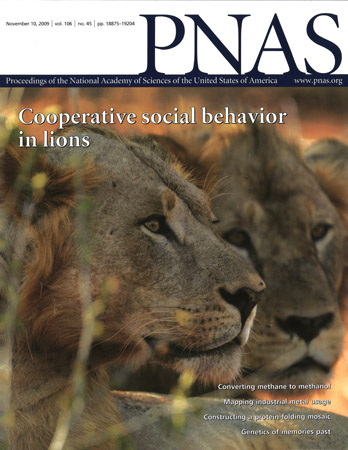
Biology Under Cover Abstract
Selected Journal & Book Covers from SBS Faculty
“Cooperation and individuality among man-eating lions”
Justin Yeakel, Bruce Patterson, KenaFox-Dobbs, Mercedes Okumura, Thure Cerling, Jonathan Moore, Paul Koch, and Nathaniel Dominy
Commentary
This article was the inspiration for a New Yorkercartoon several weeks later (14 December, 2009).
Abstract
Cooperation is the cornerstone of lion social behavior. In a notorious case, a coalition of two adult male lions from Tsavo, southern Kenya, cooperatively killed dozens of railway workers in 1898. The ‘‘man-eaters of Tsavo’’ have since become the subject of numerous popular accounts, including three Hollywood films. Yet the full extent of the lions’ man-eating behavior is unknown; estimates range widely from 28 to 135 victims. We used stable isotope ratios to quantify increasing dietary specialization on novel prey during a time of food limitation. For one lion, the δ13C and δ15N values of bone collagen and hair keratin (which reflect dietary inputs over years and months, respectively) reveal isotopic changes that are consistent with a progressive dietary specialization on humans. These findings not only support the hypothesis that prey scarcity drives individual dietary specialization, but also demonstrate that sustained dietary individuality can exist within a cooperative framework. The intensity of human predation (up to 30% reliance during the final months of 1898) is also associated with severe craniodental infirmities, which may have further promoted the inclusion of unconventional prey under perturbed environmental conditions.
